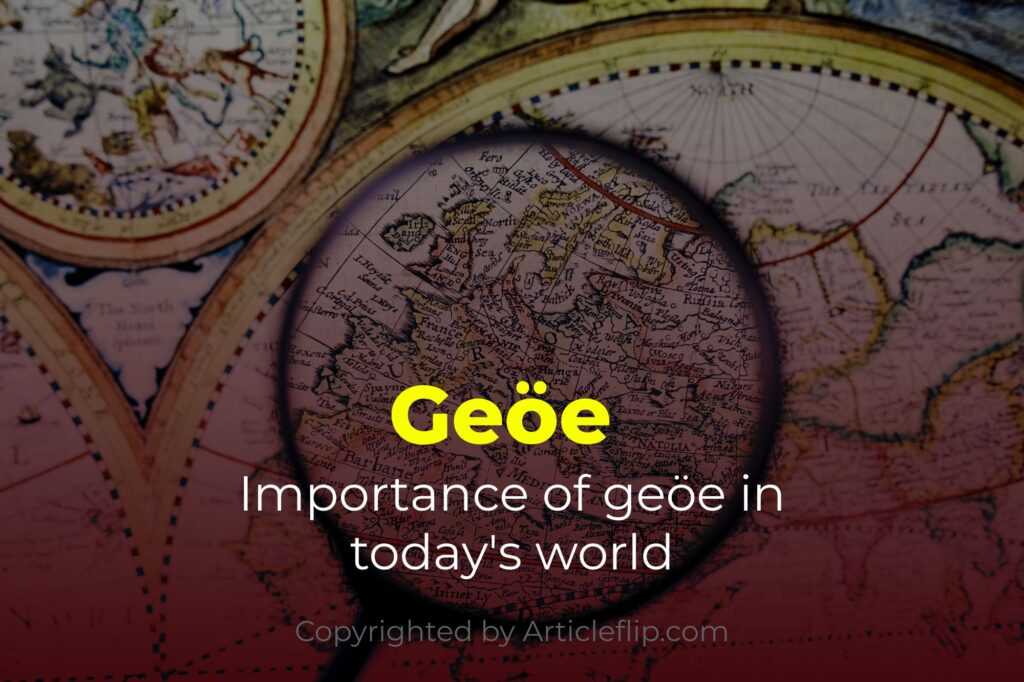Table of Contents
Introduction to geöe
What is geöe?
Geöe, also known as geographical information systems (GIS), is a technology that captures, analyzes, and manages spatial or geographic data. It allows users to visualize, interpret, and understand the relationships between various geographic features and phenomena. Geöe combines elements of cartography, statistics, and computer science to provide valuable insights into the earth’s surface and its attributes.

Importance of geöe in today’s world
In today’s interconnected world, geöe plays a critical role in a wide range of fields and industries. From urban planning and environmental management to disaster response and public health, geöe helps organizations make informed decisions and solve complex problems. By providing accurate spatial information, geöe enables better resource allocation, improved efficiency, and enhanced collaboration among stakeholders.
History and Origins
Origins of geöe
The roots of geöe can be traced back to early human civilizations, where people used rudimentary maps and spatial knowledge to navigate their surroundings and communicate information about the landscape. Over time, advancements in technology, such as the compass and the telescope, laid the groundwork for more sophisticated mapping techniques and spatial analysis methods.
Evolution of geöe over time
The modern concept of geöe began to take shape in the mid-20th century with the advent of computers and digital technology. In 1962, Roger Tomlinson developed the first computerized mapping system to manage resources in Canada, marking the beginning of the GIS era. Since then, geöe has evolved rapidly, with advancements in hardware, software, and data collection methods expanding its capabilities and applications.
Features of geöe
Unique characteristics
One of the key features of geöe is its ability to integrate different types of spatial data into a single database, allowing users to analyze and visualize information from various sources. Geöe also provides tools for spatial analysis, enabling users to perform complex calculations and simulations to model real-world scenarios. Additionally, geöe offers customizable mapping interfaces that allow users to create interactive maps and visualizations tailored to their specific needs.
Comparison with similar concepts
While geöe shares similarities with disciplines such as cartography, remote sensing, and surveying, it offers distinct advantages in terms of data integration, analysis capabilities, and user interface. Unlike traditional maps, which provide static representations of geographic features, geö allows for dynamic, interactive mapping experiences. Similarly, while remote sensing focuses on capturing data from a distance, geö encompasses a broader range of data sources and analytical techniques.
Applications of geöe
In business and marketing
Geö has numerous applications in business and marketing, including site selection, market analysis, and customer targeting. Retailers use geö to identify optimal locations for new stores based on demographic trends and competitor locations. Similarly, marketers use geö to target advertisements to specific geographic areas and track consumer behavior across different regions.
Cultural impact
Geö also has a significant cultural impact, particularly in the fields of archaeology, heritage preservation, and tourism. Archaeologists use geö to map and analyze ancient sites, track changes in landscapes over time, and plan excavation projects. Heritage preservationists use geö to document and restore historical landmarks, ensuring their conservation for future generations. Additionally, geö plays a vital role in promoting tourism by providing interactive maps, virtual tours, and location-based experiences.
Environmental applications
In the realm of environmental science and conservation, geö is instrumental in monitoring natural resources, managing ecosystems, and mitigating environmental hazards. Scientists use geö to track changes in land use, deforestation rates, and wildlife populations over time. Conservationists use geö to identify critical habitats, plan protected areas, and monitor biodiversity hotspots. Additionally, geö helps policymakers and government agencies develop strategies for climate change adaptation, disaster response, and sustainable development.
Challenges and Limitations
Technical challenges
Despite its many benefits, geö faces several technical challenges, including data quality issues, interoperability issues, and scalability limitations. Ensuring the accuracy, completeness, and consistency of spatial data can be challenging due to factors such as data collection errors, outdated information, and varying data formats. Additionally, integrating data from different sources and platforms can be complex, requiring robust data management and processing capabilities. Scalability is also a concern, as geö systems must be able to handle large volumes of data and support multiple users simultaneously.
Ethical considerations
Ethical considerations surrounding privacy, security, and data ownership are another significant challenge for geö. The collection and use of spatial data raise concerns about individual privacy and surveillance, particularly in the context of location-based services and geolocation tracking. Additionally, the sharing and dissemination of sensitive geö data can pose security risks, exposing organizations to potential data breaches and cyberattacks. Furthermore, questions of data ownership and intellectual property rights can arise when multiple parties contribute to or use spatial data for different purposes.
Future Prospects
Potential advancements
Looking ahead, the future of geö is promising, with ongoing advancements in technology driving innovation and growth in the field. Emerging technologies such as artificial intelligence, machine learning, and the Internet of Things (IoT) are poised to revolutionize how geö data is collected, analyzed, and applied. These advancements will enable new opportunities for spatial analysis, decision-making, and problem-solving across a wide range of industries and sectors.
Conclusion
In conclusion, geö is a powerful technology that has transformed the way we understand and interact with the world around us. From its humble origins in ancient cartography to its current applications in business, culture, and the environment, geö has become an indispensable tool for decision-making and problem-solving. As technology continues to evolve, the potential for geö to drive innovation and positive change in society is virtually limitless.
If you found our content helpful don’t forget to share it on your social media: Twitter
More Related: Antiquità: The Rich Tapestry of Ancient Civilizations
